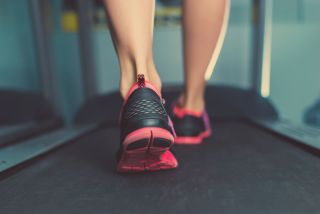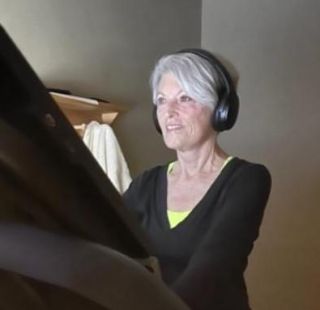Motivation
How I Got Myself to Exercise
Personal Perspective: Find your personal solution by looking into your own mind.
Posted October 16, 2023 Reviewed by Michelle Quirk
Key points
- Rather than try to change yourself using willpower, find a solution that fits your psychological makeup.
- Find a way to make exercise truly pleasurable.
- When the alternative to "late" is never, accept "late."

If you saw how fit I am today, at 77, you might think I’m one of those sportive types who love to sweat and push themselves physically. But you’d be wrong—totally wrong. I so dislike exercise (let alone sweating!) that I have to trick myself into doing it.
The hurdle was high. My natural inclinations work against me. I’d rather sit than stand. I’d rather lie down—with a book—than sit. Even as a kid, I never saw the appeal of physical games, particularly ones involving balls, which I never cared if I caught. Races, too. I didn’t push myself, because I didn’t care if I lost.
My mother used to say that if she had it to do all over, she’d have exercised. Why, she didn’t say, but since this is the only life advice she ever gave me, I tried to follow it. I tried all kinds of exercise but couldn't get myself to stick with any. Once I was pushed into visiting a gym, one filled with spandex-clad people pumping away on a variety of machines, a nightmare vision. The office manager sold me on the huge savings in packages, so I prepaid for a year, thinking it would get me to go. I never returned. As the weeks passed, and my guilt mounted, so did the barrier to my going, just like when you don’t return a call and don’t return it and don’t return it, until you just can’t.
The Insight That Got Me Going
So, this is what I’ve learned: if I am going to exercise regularly—which is essential in exercise—it has to involve real pleasure. Aspirational goals, whether squeezing into those jeans or just getting fit, don’t work for me. It has to be fun—now.
The first program in which I had any success was jogging with a friend, which I stuck to because you can talk while you’re doing it. Since we started when our kids were little and we were early in our careers, we had a lot to talk about: parenting worries, marriage worries, work worries, and the kids! The talk was so helpful—life-saving, really—it stopped being incidental to the jogging and became its purpose.
But there was a major drawback: I was completely dependent on my friend’s availability. If her schedule changed, and she couldn’t make it, I didn’t jog. With no intimate conversation to distract me, with no one to keep up the pace, I slowed, until I was strolling. I needed a different kind of distraction from exercising, I realized—one I could enjoy alone.
This is when the solution came to me. When we first moved into our apartment, my husband turned a large closet into a darkroom with equipment he’d gotten for free but never used. One night, he came home to find a treadmill in its place. The smallest one barely fit, which can be dangerous if you lose your footing and are going fast. But I had no intention of going fast. My plan was to watch movies on a small TV hung on the wall in front and to walk at the fastest speed that wouldn’t disrupt my absorption in the film.

It worked like a dream. A treadmill moves you; you don’t move it. In the dark, with earphones on, immersed in a film or TV series, I’m completely unaware of exercising. If I’m hooked on a series, I can’t wait to get on the treadmill each day. With streaming, I’m almost tempted to binge-watch. Sometimes my husband does, and I have to pull him off.
The Benefits
Over the years, I’ve stepped up the pace as my body has adjusted. By increasing the speed or angle of the incline so slowly that I barely notice it, I’ve become a naturally fast walker, without trying. I pass everyone on the street. I run for the subway or up the stairs when I hear a train coming. I walk up the escalator. I often take the stairs, because I can’t be bothered to wait for the elevator. Me!
It turns out that regular walking has tremendous health benefits for the average person. According to a 2023 study, 30–45 minutes of walking five times a week, added to what you normally do in a day, substantially reduces the risk of premature death from all diseases, not to mention improving the immune system and mental health.
It’s great to strengthen your lower body and heart, if not quite enough. Many years ago, my husband broke his hip and had to do physical rehab, followed by strength training, which he was told was the only way to recover fully. He pressured me into joining him. I didn’t like it, but we went together, so not going was not an option. I was surprised to see that twice-weekly sessions resulted in visible improvement. Exercises that were agony in the beginning became doable in a matter of weeks. But my progress is not the pleasure that keeps me going. Nor, even, is it my internist’s approval.
Now, what keeps me going is the fun of clothes shopping. My body shape has changed. After several years of almost daily movie-watching on the treadmill, I was surprised to realize I’d dropped a size. By then, I’d developed a similarly personal, fairly painless way of stabilizing my lifelong, rollercoaster weight. (You can read about it in two posts, on this site.) To my surprise, my weight keeps inching down. Since puberty, I’ve dressed to conceal figure flaws. Now, I can wear whatever I like. I remember the thrill of buying my first narrow skirt, until then an unthinkable option. I was in my 60s. It would have been wonderful to have gotten to where I am earlier in life, but my mantra is “better late than never.” And, for me, it truly was: “late” or “never.”
Do not be deterred, if you are getting a late start. The health benefits of regular exercise are immediate, even if they’re not quickly visible. Treadmills aren’t cheap, but you can buy a used one or join a gym and bring a portable device to watch your shows on. Or find another activity with a big component of fun: square-dancing, Zumba classes, fast-walking to work with earbuds, and mysteries on tape or the music of your youth. Get a friend to join you.
My approach is the opposite of what most people do, who strive for slim fitness. I don’t seek gains, just consistency—but the gains come anyway. I’m the turtle, not the hare. The road I take is very, very slow, but it’s taken me very, very far. It can take you there, too.
References
Banach, M., Lewek, J., Surma, S., (2023) The association between daily step count and all-cause and cardiovascular mortality: a meta-analysis. European Journal of Preventive Cardiology. https://doi.org/10.1093/eurjpc/zwad229




